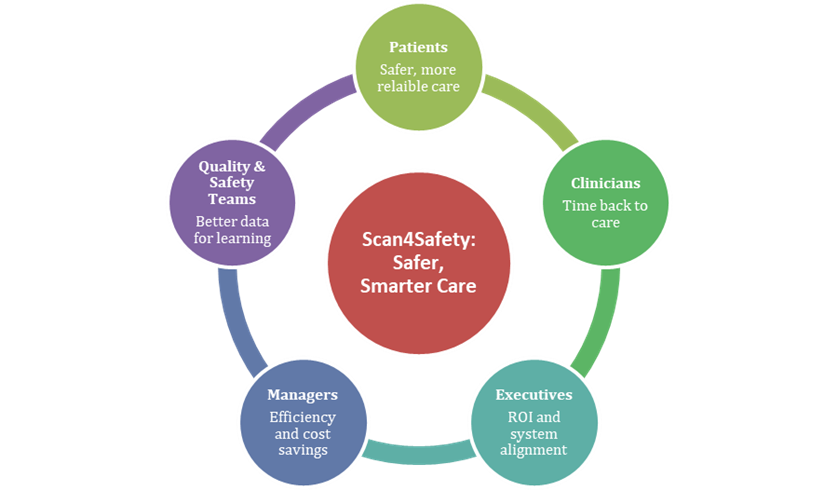Transforming patient safety and operations
Evidence from early adopter trusts demonstrates that Scan4Safety delivers safer care by improving accuracy of patient, product, and procedure matching. This prevents the use of expired, recalled, or incorrect products, and enables rapid, targeted recalls when needed.
The programme also releases thousands of clinical hours through streamlined stock and asset management, reducing duplication and manual processes. This gives staff more time back to care while delivering financial savings and sustainability benefits through waste reduction, improved procurement, and inventory optimisation.
Scan4Safety helps trusts meet regulatory compliance requirements, supporting national and international standards for device tracking and data capture. When product recalls are necessary, they can be completed in days rather than weeks, with accurate patient tracking and tracing to ensure those affected are quickly identified and protected.
Perhaps most importantly, clinicians report a culture shift, with greater confidence and safety assurance in their daily practice.
Results that matter
- At Leeds Teaching Hospitals, scanning released the equivalent of 16,000 hours of clinical time annually back to patient care.
- Royal Cornwall Hospitals NHS Trust reduced medication error rates by 76% by introducing scanning in pharmacy.
- North Tees and Hartlepool reduced stock count time from two days to just 30 minutes, freeing staff for direct patient care.
- Derby Teaching Hospitals prevented potential harm by identifying seven expired products in theatres in a single day through barcode scanning.
The six demonstrator sites together reported £5.6 million in savings in just the first year of implementation.
What trust leaders are saying
“Scan4Safety is a pioneering initiative to bring 21st century data standards to our everyday work in the NHS. I’m proud that at Leeds Teaching Hospitals, we were one of the original demonstrator sites and it has shown improvements in how we track patients and equipment around our seven hospitals, and, crucially, frees up staff time so they can spend more time focusing on patient care.”
Julian Hartley, Chief Executive, Leeds Teaching Hospitals NHS Trust
“It’s changing the experience for all of our users… our patients, by making sure we have the right product in the right place at the right time.”
Tom Burton, Director of Finance, The Princess Alexandra Hospital NHS Trust
“The investment in time at the start is dwarfed by the size of the benefits and the efficiencies that it brings after you have implemented.”
Tom Burton, Director of Finance, The Princess Alexandra Hospital NHS Trust
Benefits across different care settings
Hospital settings
Theatres benefit from scanning of implants, high-risk devices and consumables to ensure full traceability, supporting safer outcomes and smooth operational flow. Theatre staff are also alerted to wrong selection of products, incompatible components, expired items, product recalls and patient safety warnings and notices. Blood transfusions become safer by linking patients, products, and transfusion events. Hospital pharmacies achieve safer dispensing and administration of medicines, supporting Closed Loop Medicines Administration ambitions.
Outpatient and ambulatory care
Dialysis units ensure accurate linkage of patients, consumables, and treatment records. Diagnostic laboratories improve tracking of patient samples and devices to guarantee accuracy and reliability of results.
Community and primary care services
Virtual wards benefit from safe management of care and equipment for patients at home. Community and primary settings see improved traceability and accountability for devices used outside hospital walls. Patient-loaned equipment ensures accurate records and appropriate servicing of equipment used in community settings.
Impact by user group

For patients
Safer procedures, fewer errors, faster responses to product recalls, and assurance that the right care is given first time, every time. Financial savings can be reinvested into patient care.
For clinicians
Less time spent on administration and stock checks means more time with patients, plus confidence that the right product is always at hand and added protection against errors.
For managers and procurement teams
Access to accurate usage and cost data, streamlined ordering, reduced duplication, and improved supply resilience.
For quality and safety teams
Reliable, standardised data for investigations, audits, and learning from incidents.
For executives and leaders
Demonstrable return on investment, alignment with NHS priorities on safety, digital transformation, and efficiency, plus scalable improvement across systems.
Every scan makes a difference
Every scan is a safety check that protects patients and prevents errors. Every scan gives staff more time to focus on patient care rather than administrative tasks. Every scan gives the NHS clearer insight into how care is delivered and where improvements can be made.
From a patient perspective, those in demonstrator trusts report greater confidence in their care when they learn that products used in their treatment can be traced directly to them, supporting safer outcomes and accountability.
Scan4Safety is not about technology for its own sake. It’s about making care safer, faster, and more reliable for every patient.
